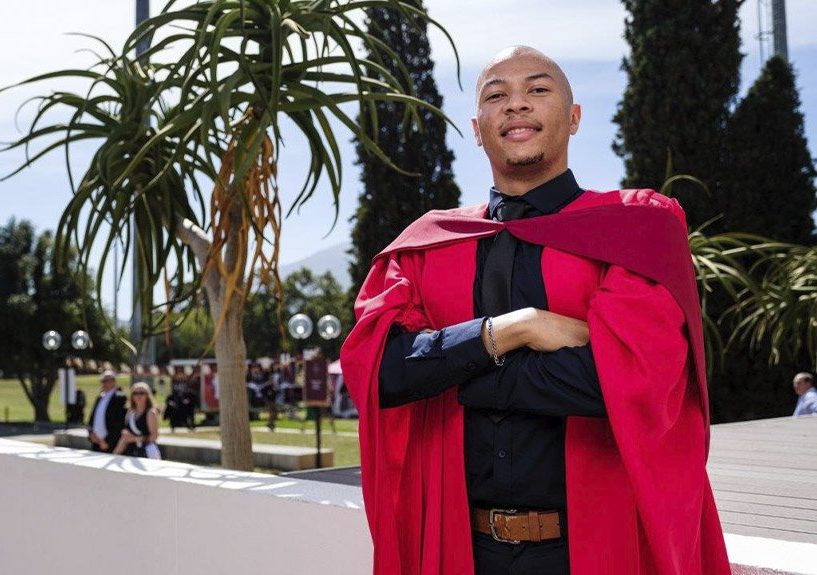Obtaining a PhD at 26 is already a massive achievement, but what makes Dr Steve Chingwaru’s graduation from Stellenbosch University (SU) even more remarkable is his groundbreaking geomatallurgy research that has garnered interest from mining companies around the globe.
Chingwaru has uncovered what is potentially the world’s largest invisible gold resource.
Originally from Zimbabwe and growing up in Johannesburg with his aunt, the gifted geometallurgist has mining in his blood. Chingwaru is the grandson of the legendary prospector George Nolan who discovered lithium in Zimbabwe and even wrote a book, Road to Lithium Lodge, about his adventures looking for precious metals in the wilderness of what was then southern Rhodesia.
Although his grandfather lost most of his fortune, Chingwaru’s future looks bright. His findings could help unlock gold to the value of R450 billion that is hiding in plain sight within the unsightly mine dumps around Johannesburg.
Uncovering a hidden gold mine
Historical mine waste from the Witwatersrand called tailings, contains over six billion tonnes of material with significant gold content, Chingwaru explains. The research for his Master’s degree, which was upgraded to a PhD along the way, aimed to calculate and characterise these gold reserves. He also explored ways to extract the gold efficiently while addressing environmental concerns related to the tailings, such as the release of acid mine drainage due to pyrite oxidation.
“Invisible gold” – minuscule particles locked inside other minerals – is nothing new. But Chingwaru is the first scholar to calculate that the six billion tons of tailings around Johannesburg’s mines contain up to 460 tons of gold.
“Historically, the low concentration of gold inside tailings was considered too low grade to be of value. But now that extensive mining has depleted most of the high-grade concentration of gold, it’s becoming unfeasible to mine – some shafts are already reaching 4 km underground. Looking for gold in low-concentration sources is becoming more viable,” Chingwaru notes.
Some big mining companies have started to process the tailings to extract the leftover gold, but the traditional way of extraction through cyanide is not very effective and also damaging to the environment, Chingwaru points out. “Typically, they manage to extract just 30% of the gold through this process. So, in my PhD research, I asked where the remaining 70% is and how it can be safely removed from the pyrite.”
As a child growing up in Alberton, Chingwaru thought the mine dumps were just a natural feature of Joburg. “When it was windy in August, the dust would turn everything in our house orange,” he remembers. Having now analysed samples from tailing dumps in Carletonville, Central Rand, Evander and Klerksdorp Goldfields, Chingwaru knows the nuisance he experienced in his youth is extremely dangerous for the environment and humans.
“When sulphides become oxidised, they produce sulphuric acid, and when that goes into the groundwater, it increases the mobility of several toxic elements. It’s a big problem in some parts of Johannesburg where they’re scared that their groundwater is becoming polluted by tailings-related acid mine drainage. That’s why I’m passionate about highlighting the economic potential, as well as the environmental benefits of reprocessing tailings dumps efficiently.
“If you process the pyrite, you are taking out the key cause of acid mine drainage, plus you’re getting economic value from it. The process has the potential to recover additional valuable byproducts such as copper, cobalt and nickel, and reduce or even eliminate the heavy metal pollution and acid mine drainage associated with tailings dumping,” Chingwaru says.
Academic acclaim
In his short scholarly career, Chingwaru has become somewhat of a celebrity academic. His research has been published in top industry journals such as Mineral Processing and Extractive Metallurgy Review and Minerals Engineering and he’s been featured in news media and radio shows. At the end of last year, he was invited to a meeting hosted by the Public Protector in Johannesburg to discuss the environmental impact of illegal mining.
When Chingwaru presented his work at a conference of the Prospectors and Developers Association of Canada, his research was voted the third best at the world’s largest international conference on minerals exploration and investment.
Chingwaru credits his supervisors, Dr Bjorn von der Heyden from the Department of Earth Sciences, and Dr Margreth Tadie from the Department of Process Engineering, for inspiring and guiding him to greater heights. “I’m extremely grateful that they pushed and encouraged me to think big. They gave me free rein to follow my instincts.” They are co-authors of his recent article “An underexploited invisible gold resource in the Archean sulphides of the Witwatersrand tailings dumps”, published in the prestigious journal Nature Scientific Reports.
During his time at SU, the Department of Earth Sciences became his second home, Chingwaru says. “My lecturers and fellow students are the most welcoming people I’ve ever encountered. They became like family. I made friends for life in Stellenbosch.”
Future plans
With his PhD in the bag, Chingwaru is considering different employment options, but his first choice would be to join Prof Anita Parbhakar-Fox at the Institute of Sustainable Minerals in Australia. Alternatively, he would consider going to Germany to join the Helmholtz Institute Freiberg for Resource Technology where there are excellent facilities to study mining waste.
With his sister and mom still living in Zimbabwe, Chingwaru says he never wants to lose touch with his roots. “I’m very proudly African, I love this continent to bits and I’m always encouraging people to come here. There are brilliant scientists in Africa, we’re just not bringing out the full potential of our brightest minds. It’s high time that Africans make discoveries that benefit us all.”
Talking about his difficult childhood, Chingwaru says his early struggles taught him to be goal-orientated and resilient. “When I stayed with my auntie, life was very, very hard. My dad had died before I was born and my mom struggled to raise three kids. From an early age, I knew I had to set goals and have a plan to overcome poverty. As I got older and more interested in science, I realised material things are nice, but it’s more worthwhile to strive for discovery. That’s what motivates me – the adventure of scientific discovery.”
When he was in matric, Chingwaru decided to retrace his grandfather’s footsteps to visit Lithium Lodge in Zimbabwe. “My grandfather was a very colourful character. Going back in his footsteps to where he discovered the Bikita pegmatites, one of the biggest deposits of lithium in Africa, was a journey of self-discovery. The area was bombed during the civil war, so there is very little left of the original infrastructure. The house is overgrown, all you can see is the ruins. People there were very amused to meet the grandson of the famous prospector. I think that piqued my curiosity to go into earth science.”
Source: Stellenbosch University







